Pop-Up Photography New York! Was a Successful Launch in NYC
Classic Photograph Fair Launches in London in mid-June after a Year Delay
Summer Sale on Vintage Works, Ltd.: 30% off Selected Images and Free Ground Shipping in the U.S.
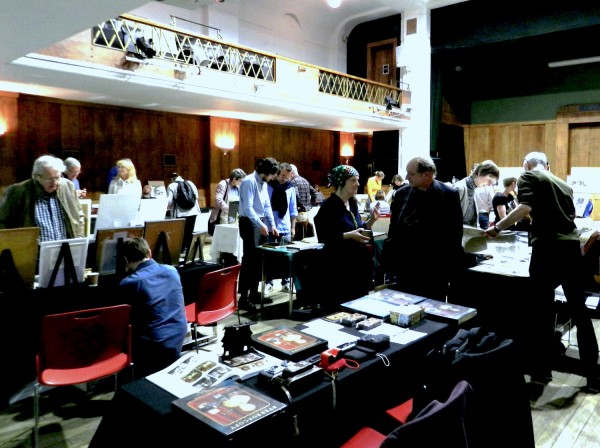
The Classic Photograph Fair's first edition in London.
It was well worth the wait. The Classic Photograph Fair, organized by Daniella Dangoor and sponsored by Chiswick Auctions, was originally scheduled to have its inaugural edition in May 2020, tying in with Photo London at Somerset House. And then the pandemic set in. Both fairs were re-scheduled for autumn the same year, and then cancelled again. Photo London finally went ahead September 8-12, 2021, but Dangoor decided to wait with her fair and not to tie it in with this year's edition of Photo London, which went ahead May 11-15.
Those of you who haven't visited London over these last few years may wonder what has happened with The London Photograph Fair, the city's long-standing tabletop fair, as well Photo London and the effects of Brexit on the trade, and I will deal with the latter later.
There was a strong line-up at the new fair of 20 exhibitors, not just the regular tabletop dealers, including Richard Meara, Linus Carr, James Kerr and Hugh Rayner, but also James Hyman, Maggs Bros, Robert Hershkowitz, and England & Co.
Dangoor's fair is not the only new tabletop fair in London. In 2019, James Kerr started up The Bloomsbury Photograph Fair as "a fair within a fair", held in conjunction with The Bloomsbury Book Fair. Dangoor and Kerr's fairs have risen out of the ashes of The London Photograph Fair, which would have marked its 40th anniversary this year, had it still been going.
Richard Meara took charge of The London Photograph Fair in 1998. After 14 years, Meara handed over the reins of the fair to Kerr, one of its regular exhibitors. In 2015, the fair was taken over by Jane Orde, Arnaud Delas and Daniel Newburg, the latter being the promoter of the first and short-lived Photo London, which was then taken over by Reed Exhibitions and cancelled after one edition.
Orde and Delas bailed out some time after that, with Newburg continuing on his own. It got increasingly chaotic. Dates were scheduled, then cancelled. The fair effectively ceased to be. Or as several exhibitors have put it to me, "He killed it". There was a great deal of anger and bitterness about this. London needed a tabletop fair, not just to buy and sell but to connect and reconnect, so the initiatives by Dangoor and Kerr have been most welcome.
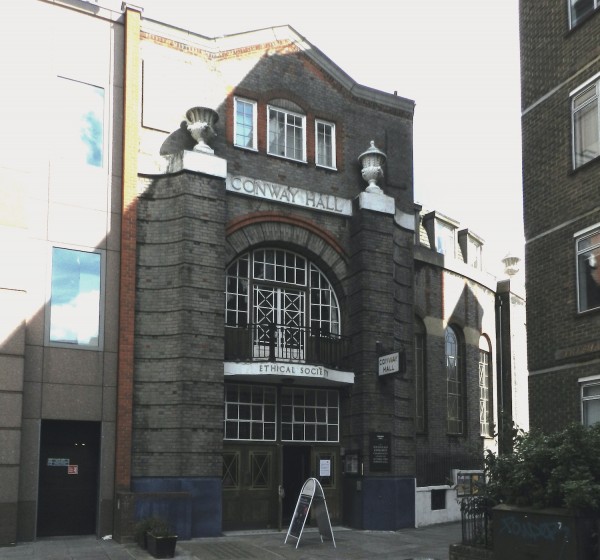
The Show venue was located on Red Lion Square in Bloomsbury, within walking distance of the British Museum. Conway Hall is owned by the Conway Hall Ethical Society.
Dangoor had chosen the venue well. Located on Red Lion Square in Bloomsbury, within walking distance of the British Museum, Conway Hall is owned by the Conway Hall Ethical Society and was opened in 1929, its name chosen in honor of Moncure Daniel Conway (1832-1907), anti-slavery advocate, out-spoken supporter of free thought and biographer of Thomas Paine.
The hall itself is large and airy, with beautiful, wood-paneled walls. The Red Lion Café in the square was opened on a Sunday especially for the fair, and the vouchers Dangoor handed out were greatly appreciated by the exhibitors.
At the book and photograph fair, there's usually a long queue at opening time and a couple of hours later the crowds have largely thinned out. There wasn't a long queue here but people kept coming throughout the day, including Michael Hoppen, Timothy Prus, Sean Sexton, Lindsey Stewart, Robert Flynn Johnson, Terence Pepper, Ben Burdett of Atlas Gallery, and the British artist Paul Hodgson. I met the Italian collector/dealer Enrico Abrate who told me that he and his business partner were about to open a space in Bergamo, northeast of Milan.
Brexit did have an impact on the fair, as it has had on Kerr's fair, with fewer exhibitors from the EU. The Brexit transition period ended December 31, 2020 and export sales from the UK to the EU plummeted. While they have recovered somewhat in some sectors, many businesses now find the EU the hardest place in the world to export to. And that includes even sending simple things like catalogues. And it doesn't look like it's going to get easier in the near future. Quite the contrary, as a trade war may be in the cards over the Northern Ireland Protocol. Many European dealers find the bureaucracy just too complicated to deal with and have decided to give the UK a miss.
Dangoor needed to have a sufficient number of exhibitors, and, alongside the vintage dealers, she had invited three artists working in what is now called alternative processes to participate, Ellspeth Ross, Yoke Matze and Anthony Jones. Dangoor explained to me, "I liked having contemporary artists using early or alternative processes, I thought it would rejuvenate the fair, and I'd like to expand their number next year. One of them did well, and I hope that the other two will benefit from the exposure further on."
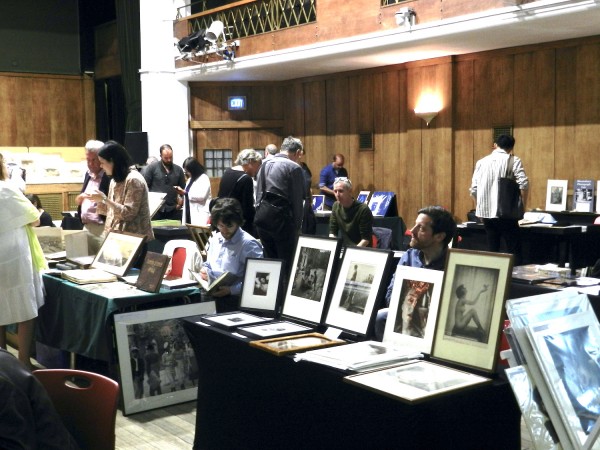
Brexit had its impact as there were fewer dealers from the Continent, but Fair Organizer Daniella Dangoor hopes that "word will get around that this is a worthwhile fair, and that I'll get a couple more exhibitors next year."
Dangoor continued, "I would have liked more continental exhibitors, but I understand the difficulties posed by Brexit. I hope word will get around that this is a worthwhile fair, and that I'll get a couple more exhibitors next year. As for visitors, they kept coming throughout the day, so there was a real buzz. Traditionally you get a rush in the morning then it gets quiet. This was more pleasant. Obviously, I need to get more people to come. It's a learning curve. But the exhibitors were very kind with their praises for the fair, and very positive, looking forward to next year."
Denis Pellerin wrote that the people he directed to the fair enjoyed it. "People liked the space and the ease of access. Flyers need to be tweaked, as well as better distribution, more social media. There was a flurry of posts by exhibitors the day before, but they should be encouraged to post more and earlier."
Dangoor had her own stand at the fair, "I brought a selection of images of Samurai, including wonderful images by Beato, images of India and some eclectic material including a wonderful portrait of the French film director Abel Gance, in the role St. Just in his epic film Napoleon. Unsurprisingly, I did not do well. It just seems to be par for the course for me at fairs."
As stated, Dangoor and James Kerr's initiatives have now replaced the London Photograph Fair. I asked Kerr to comment on this, "A number of years on from relinquishing control of the London Photograph Fair, I was not in the market for running another fair. I really enjoyed our time doing it, but it took quite a lot of time away from the core business, and we decided to focus on buying and selling. So, I'm happy to help promote it, and it is being done with the encouragement of a number of other dealers. Kim Jeffrey from Etc. Fairs has agreed to run what is effectively a 'fair within a fair' twice a year as part of the Bloomsbury Book and Ephemera Fairs. These fairs have been a regular fixture on the calendar for a long time, and have now moved to our former home in the Holiday Inn Bloomsbury. It makes sense for a number of reasons. There is considerable crossover between the two constituencies; you see a lot of the same faces at the book fairs as you would have done at the photography fairs, and hopefully there is room for a bit of cross-fertilization. In addition, the reality of the market is that there are not the same number of UK dealers offering vintage photography as there were even five years ago. Being part of an established event makes more sense rather than trying to attract customers a stand-alone show where the trade forms a significant proportion of the client base. We need a regular tabletop event in London where the dealing community can meet up, without significant overheads, and can sell both to each other and to the collecting public. In that sense the Bloomsbury Fair and the Classic Photograph Fair can complement each other well."
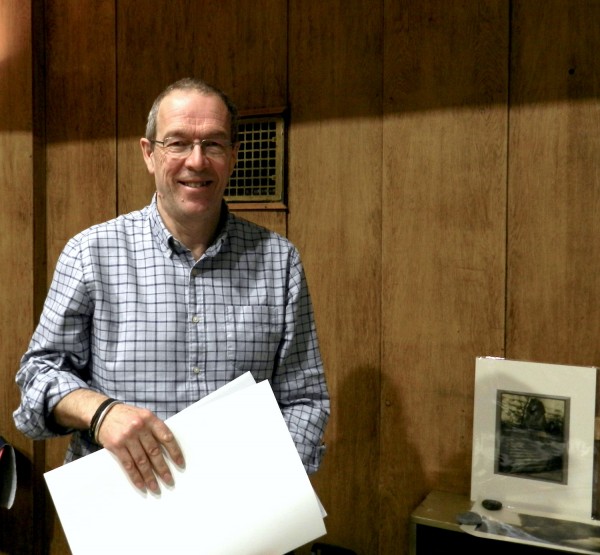
James Kerr has been a fixture in the London photo market for years after taking over the London Photograph Fair from Richard Meara. He recently stepped back from that role to turn over that fair to Kim Jeffrey from Etc. Fairs, who has merged it into the Bloomsbury Book and Ephemera Fair.
Kerr had enjoyed the fair, "Credit to Daniella for deciding to try a new event. From experience I know that fair organizing is not an easy task, and I thought for a first edition, it was a very credible showing. I liked the venue; a good-sized room for the number of dealers and visitors, a pleasant atmosphere, and while it was a little tucked away, we have to accept that we are not looking for passing footfall, but for dedicated enthusiasts. I hope she does it again next year, although I do think it would make sense to run it the same weekend as a major event, such a Photo London, which acts as a magnet for international buyers. Building awareness is a slow process, but you have to keep at it. There is space for another event in the calendar. The Bloomsbury Fair runs twice a year and we needed something late spring or early summer, perhaps pitched at a slightly different point in the market."
I asked Kerr about sales, "My inventory was not as fresh as I would have liked. As a mainly online dealer I have sold well though the past two years, but I have found it difficult to replace stock, as there was little movement in the marketplace. That said, I did have some good fresh pieces, including a particularly striking albumen print of the king of Siam, Rama V by Francis Chit. Sales were adequate given those qualifications and the fact that I had sold well at Bièvres the weekend before. I see a little more movement in the marketplace and would anticipate having stronger inventory in the autumn."
Richard Meara was very pleased with the sales he achieved, "I had been saving up material for this fair since 2020 when it was first planned to run, both 19th and 20th century items. I sold all the botanical studies by Scowen that I brought, all in superb condition. I also sold all the Samuel Bournes of Kashmir that I had, to different buyers, again in top condition. Two pieces that I was sorry to see go were a nice "Water Rats" by Frank Meadow Sutcliffe, and a very rare hand-colored salt print by James Robertson of a scene in Constantinople. I made a last-minute decision to bring my box of vernacular prints and snapshots priced at £5 and £10 each, and was glad I did, as they not only sold well but kept people busy going through them for ages. Overall, I did better than I had expected, selling to the trade and to visitors."
Meara had enjoyed the fair and was looking forward to next year's edition, "I think the fair went very well for a first showing, and Daniella Dangoor and Chiswick Auctions are to be congratulated. The location was good with helpful staff, and the hall was just right for the number of dealers. Parking was no problem, and Daniella had done wonders to get the cafe in the square to open for us. She had gathered an impressive line-up of dealers, with some not normally seen at table top events such as Robert Hershkovitz, James Hyman and Jane England. As I wandered round during the day I was impressed with the standard of material on offer. It was really good to have the contemporary photographers doing alternative processes though I do not know how successful they were with sales. I hope future fairs can build on this mix."
As for visitors, Meara said, "Numbers through the door are always an unknown quantity at these events, and while it would have been good to see more visitors, they continued coming in until near the end. Early in the day the room had a real buzz about it. It was excellent to see Adnan Sezer and Olivier De Georges from France, so I hope they are encouraged to return. Keeping the website alive and refreshed during the year will be a help, and possibly some more targeted publicity. But it was a very good start."
Denis Pellerin, photography historian, expert on stereoscopy and curator of the collection of Brian May, had taken a table. Pellerin and Rebecca Sharpe were wearing t-shirts to remind visitors of Stereoscopy Day, June 21st. Pellerin had enjoyed the fair, "It was a good fair set in a very pleasant venue and with a fairly wide selection of dealers and photographs. There was a lot to go through and discover, and it was great not to examine the photographs on a screen but to actually be able to have the originals in one's hands. Warmest thanks to Daniella Dangoor for organising the event and congratulations for making it a successful one."
Pellerin had brought his impressive book "Stereoscopy–The Dawn of 3-D" edited by Brian May, and published last year, "There was some interest in it and lots of questions. We had several people looking at images with the Owl viewer we had set up on the display copy. It was a photo fair so books were a little out of place maybe but it is always nice to explain stereoscopy to people who do not know much about it and to listen to their "Wow" when they manage to get the two halves of the image to fuse into a unique three-dimensional one. This is the magic of stereoscopy and I can never get tired of it!"
I asked Pellerin if he had met people here that he hadn't met before? "We did actually. Most of the usual buyers were there, obviously, but there were some young people too, which is always a good thing because it means there is a new generation of buyers who are getting interested in starting a collection, or at least of purchasing some photographs which are not mere reproductions. There were some rather expensive images, of course, but even if you only had a few pounds to spend you could still find great photos at most of the tables. That's the beauty of fairs. You never know what treasures you can find. The best way is not to expect anything and just enjoy the thrill of finding an image that catches your eye."
Pellerin is known for his meticulous research, and for being ever-industrious. He has a new book coming out June 21st, "Henri Lefort – The Ultimate Entertainer." It's only available as a downloadable pdf. And it's free. Pellerin explained, "With the price of everything going up fast, I thought it would be nice to offer something free for a change and, at the same time, give a chance to everyone to learn a little more about Stereoscopy. This book is about one of my favourite French stereo photographers, Henri Lefort, and I thought it would be fitting to publish it on June 21st, which is Stereoscopy Day, the anniversary of the day when Charles Wheatstone presented his invention of the stereoscope to the scientific world back in 1838." Henri Lefort – "The Ultimate Entertainer" can be downloaded here,
https://stereoscopyblog.files.wordpress.com/2022/06/henri-lefort-the-ultimate-entertainer-full-pdf-compress.pdf.
Paul Cordes at Classic Photographs had enjoyed the fair, "I feel very positive about it. The visitors came throughout the day, no great rush but steady, and people were still arriving within the last hour. It was good to some new faces too, and a few young faces. The venue is good, spacious, decent light and a nice location with some parking and close to the Holborn Tube Station. Maybe not a good venue for passing trade, but tied in with other events in London, it could work well. It is a benefit to have the square with the cafe facility and a nice area to sit."
Cordes had brought a mixture of material, "Mainly stereoviews, which were very popular, photogravures, including a Thomas Annan selection, daguerreotypes, ambrotypes and CDVs. The regular visitors were buying, and some new visitors were asking questions and making tentative buys, maybe to start a collection, which is very important. We need to encourage the new collectors of the future. I achieved good sales, with prices ranging from £5 to £850."
Cordes stressed the importance of enticing and educating new collectors. And to listen to the newcomers. "One query from a customer was interesting. He suggested having a display which explained the various processes. Important for a potential collector."
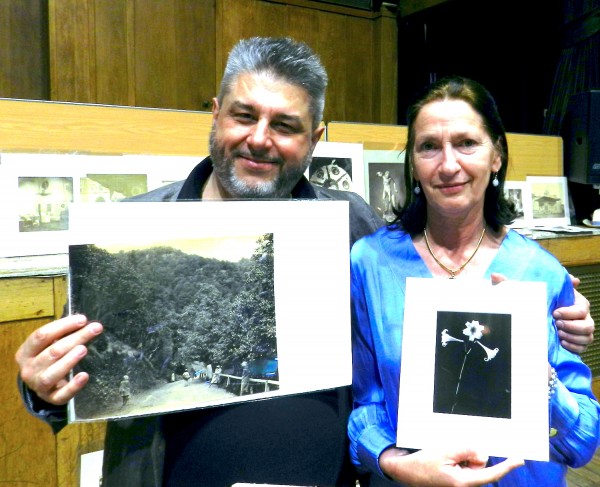
French Dealer Olivier DeGeorges and Jane Orde showing off a few of their photos at their table.
Jane Orde, had enjoyed the fair, "There was the right number of exhibitors at the fair. The atmosphere was friendly, the hall was spacious which I really liked and the tables were laid out in an intelligent way. It was great to have refreshments available in The Red Lion Café. A great effort by Daniella Dangoor I think. I brought 19th-century photographs of India, collotypes by Ogawa Kazumasa from his famous series Some Japanese Flowers, and fashion images from the 20th century. I sold four pieces, and as for sales, I totally accept that we are not in New York. And I was very pleased to sell one Ogawa to a customer I'd never met before. The little extras are important, I think. I provided professional wrapping service as well as aspirin and TLC to Adnan Sezer who was feeling unwell."
Hugh Rayner had brought a slightly more select range, "I brought Indian prints and albums, together with a box of European and Middle Eastern views, as well as a few of my Pagoda Tree Press titles, and one or two other second-hand photographic history books. I really like the venue. It has a nice atmosphere, much better than all those ghastly Bloomsbury hotels. After 40 years pottering around Bloomsbury and Holborn, I was amazed that I never knew it existed before. Red Lion Square is a very nice peaceful spot, and the cafe in the square offered good food. The visitors to my stand were nearly all the usual suspects, who used to come to see me at The London Photograph Fair, and The Bloomsbury Photograph Fair. There were one or two new faces, asking damn fool questions, but no serious new buyers."
Rayner had achieved some sales. "Very minimal sales, and almost entirely from a couple of my regular customers. I covered my costs, but not much more! Beyond the pleasure of spending the day chatting to a lot of old friends in the trade, it wasn't a financial triumph. It's always hard trying start a new fair, as I learnt to my cost when I started a fair in Bristol. The Classic Photograph Fair has great potential, but it just needs wider advertising, and well in advance."
Anthony Jones, a contemporary artist specializing in cyanotypes, was not only exhibiting his own work but also demonstrating the process. "The other dealers were of a quality that one doesn't always find. Presenting my work at fairs is something of an evangelical mission, not only explaining the history, process and meaning; but this was all well received, I hope. Visitors to my table were offered an opportunity to make a cyanotype photogram, a fair number took up the offer, which they had to pay a small fee for, and I had emails/social media responses thanking me. Given that we have come out of a long period of isolation and the cyanotype process was new to quite a few, my sales were fair, not great but the event was worthwhile."
It was also worthwhile for Linus Carr, "I sold works by Roger Fenton, Frederick Hollyer, André Giroux, as well modernist images by unknown photographers from Austrian picture agencies. In addition, I acquired an extraordinary image from Robert Hershkowitz, of Adolf Hitler, seen from the back, with a little girl in front of him, making the Hitler salute, and I sold it at the fair."
Robert Hershkowitz had brought a range of material, mainly in the low to mid-end, including works by Maxime Du Camp and Eugène Atget, as well as unknown photographers. In a brief email, Hershkowitz wrote, "Full of mixed feelings regarding the fair. Location a bit tricky. Very nice exhibition space. Crowds, there were none and very few new faces. Sales extremely slim. Thought I had a varied inventory--huge cyanotypes, nature prints, many images--all at modest prices."
Sales had also been slow for James Hyman, "I liked it very much as an event, the hall was beautiful, but we could have done with a few more collectors. I brought a variety of material, 19th-century material by Baldus and Charles Nègre, British photographers like John Blakemore and Tony Ray-Jones, ranging from £150 to £6500. Sales could have been better, but it's great that Daniella has started a fair."
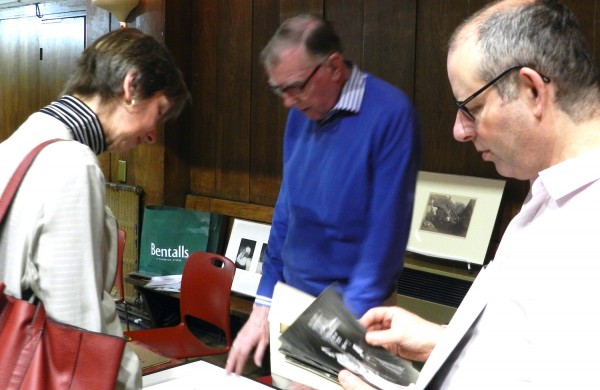
Fellow photo dealers Lindsay Stewart and James Hyman at Richard Meara's always popular table.
PHOTO LONDON AND THE EFFECTS OF BREXIT
I also asked Hyman about this year's Photo London, "The fair was quite good for us this year, and better than we expected. We had two spaces, one with classic images by André Kertész, Bill Brandt and others, and in the other we had a presentation of images of Countess Castiglione, which had great response. It's very enjoyable to do the fairs again after the pandemic, to meet people and talk about photography. I like the energy of Photo London, and it had a nice feel."
Hyman exhibited in the West Wing of Somerset House, and it felt somewhat depleted. Stewart & Skeels didn't exhibit this year, and Michael Hoppen and Augusta Edwards opted for AIPAD's The Photography Show instead. Sales had also been slow for Robert Hershkowitz and England & Co., but Roland Belgrave usually does well at Photo London and this year was no exception. Shortly after the fair opened, he sold a complete set of 12 large platinum prints of Jellyfish, by Jan C. Schlegel, called "Of Aliens, Mermaids and Medusas".
Photo London has morphed into something quite different since its inaugural edition in 2015. Most of the big galleries have been and gone; Howard Greenberg, Edwynn Houk, Robert Klein, Hamilton's, but Peter Fetterman was exhibiting again this year, showing an impressive selection of images from his book "The Power of Photography". I was also impressed by the selection of works by Erwin Blumenfeld on Parisian gallery Sophie Scheidecker's stand and enjoyed the juxtapositions of vernacular photographs at London-based The Gallery of Everything's stand.
Competing with Paris Photo and AIPAD's The Photography Show was always going to be a tall order, and the market can probably only sustain so many big photography fairs. Hopefully, Photo London will be able to stabilize, find a form that works within the market. There is faith in the fair. In February this year, it was announced that the World Photography Organization had acquired a 25% share in Photo London.
Many exhibitors at Photo London told me that they had felt the effects of Brexit, including James Hyman, "It has been absolutely terrible for us, buying and selling, because if you do it properly, following all the regulations, which we do, you can't just put something on a train or send it with FedEx. You now need customs brokers to bring things in and out of the EU. And it costs. Something that previously would have cost 100 pounds to ship now costs 800 pounds. It's cheaper for me to send something to Connecticut than to Paris, and that's ridiculous. And bringing things in on temporary import costs 150 pounds a go for the paperwork, and if you're selling works priced at 2000 pounds, that's a huge cost. And it all takes time; you can't buy something and have it ready for Masterpiece next week, which is something I would have done in the past. So it has been a disaster. It's weird for a conservative party to have no understanding of business."
There's now a potential trade war brewing over the NI protocol. I asked Hyman if he could see any light at the end of the tunnel. "Not under this government because I think it wants culture wars. It's trying to pick fights because having messed things up, it wants to blame the EU for all the problems, and so it's constantly looking for reasons to get into confrontations. The bottom line is, it's making it very hard for us. And it needn't have been this way. We could have left the union but with treaties that would have worked."
Hyman closed his gallery a few years ago but has now re-opened, with two galleries, on 48 and 50 Maddox Street, Mayfair. "We opened in March this year and currently have two exhibitions, one with images of Countess Castiglione, a different set from the ones we had at Photo London, and a 95th birthday celebration of the British artist Derrick Greaves, with paintings, collages and watercolors. Because I became known for photography internationally, many began to think I had moved away from British art but that's still the core business. The idea is to dedicate one space to inventory, the other to a rolling program of exhibitions. If you're basing what you do on your exhibition program, you don't make the most of your inventory, so having two spaces is a good solution."
Michael Diemar is a London-based collector and consultant. He is also editor-in-chief of The Classic, a new free magazine about classic photography. He is a long-time writer about the photography scene, writing extensively for several Scandinavian photography publications, as well as for the E-Photo Newsletter and I Photo Central.
Pop-Up Photography New York! Was a Successful Launch in NYC
Classic Photograph Fair Launches in London in mid-June after a Year Delay
Summer Sale on Vintage Works, Ltd.: 30% off Selected Images and Free Ground Shipping in the U.S.


Share This